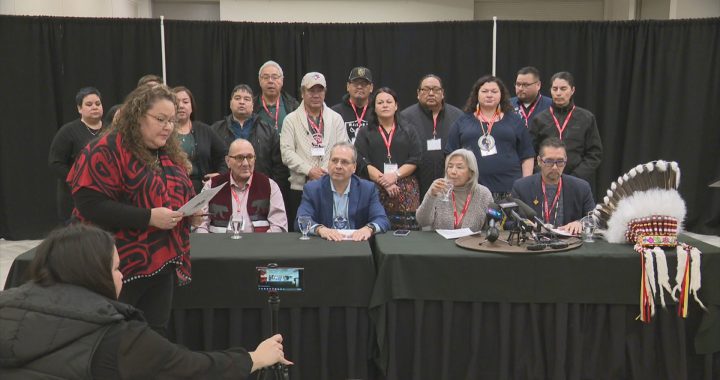(Businessman J.P.Gladu APTN/Photo)
Trina Roache
APTN National News
An Aboriginal business leader says the economy is a vital path for reconciliation with First Nations in Canada.
J.P. Gladu was in Halifax recently talking to industry, government and Mi’kmaq and Maliseet peoples. He heads the Canadian Council for Aboriginal Business.
Some of the 94 recommendations from the Truth and Reconciliation Commission focus on economic development. They call for “meaningful consultation” and “equitable access to jobs, training, and education opportunities in the corporate sector.”
“The business lens is a way we can help reconcile,” said Gladu. “We can help empower our communities by providing direct source contracting, we can get more training in front of our people, as I mentioned we’ve got a strong demographic, that is a real asset to Canada but we’ve got be able to put the resources behind it to make it become a reality.”
The news for First Nation economies on reserve has been bleak. A recent report by the National Aboriginal Economic Development Board (NAEDB) points out a widening gap for First Nations, with on reserve communities faring the worst.
It puts the average income for Aboriginal people at $20, 000 a year, which is $10,000 lower than non-Aboriginal workers. The employment rate on-reserve sits at just 35 per cent.
In the report, Chair of the NAEBD Chief Clarence Louie writes that “the opportunities for economic development for Aboriginal people today are greater than ever.” Yet at the same time, “Aboriginal people in Canada are currently not on track to achieving parity with non-Aboriginal Canadians.”
Gladu says while Indigenous communities have been marginalized, he’s sees things changing for the better. He says First Nations just have to remember their own history.
“We used to be amazing entrepreneurs back in the days of the fur trade, so we’re embracing that entrepreneurial spirit. There are a number of impediments in our way and past challenges that we’re still dealing with,” said Gladu. “But the timing is good. The idea of trades and skill development are top of mind especially with the Truth and Reconciliation Report that just came out so Canada is listening.”
The Membertou First Nation in Nova Scotia is bucking the trend. The urban reserve situated in Sydney, Cape Breton, is an economic driver for the region. A growing business park features a mix of big box and small retail stores, a Hampton Inn Hotel, and the ever-popular Tim Horton’s.
Chief Terry Paul’s office on the third floor of Membertou’s Trade and Convention centre overlooks the construction of a new sports centre.
“Membertou’s own revenues top $100 million,” said Paul. “We employ 700 people at peak seasons. Those are all people with jobs, who pay taxes, or buy consumer goods, pumping more money into the economy.”
Half of those jobs are non-Mi’kmaw people coming to work on the reserve. A sure sign that times have changed. But Paul said there’s still a lot of work to do, starting with public perception. It’s shifting, but he still runs into a lack of understanding.
“People think we’re getting something the rest aren’t, that we don’t want to work, that we don’t pay taxes,” said Paul. “We do what needs to be done to educate the public. We are good to deal with, we improve the economy, improve the tax base of the city. The jobs here? The municipality benefits more than ourselves. We contribute.”
The biggest obstacle to success for aboriginal business is the Indian Act. In the early 1900s, Indian Affairs bureaucrat Duncan Campbell Scott was famously quoted as saying he wanted to “get rid of the Indian problem.”
“Despite all the barriers, we’re still here,” said Paul. “Making a living. We’ve adapted.”
And now, Membertou is working on how to rid of the problematic Indian Act.
“The Indian Act gets in the way,” said Paul. “Always the first thing to come up, it’s hard to do anything. The land designation process is ridiculous. A major hold up is in the addition to reserves. It takes four and a half years, on average, to designate lands. Compared to six months for the municipality.”
Paul borrows a popular quote, “We need to move at the speed of business.”
And the Indian Act is an albatross in more ways than one.
“As we know, we can’t leverage, there’s no collateral,” said Gladu. “It’s really difficult to create or attract investment in our communities if there’s no safeguards to protect the investment.”
Under Section 89 of the Indian Act, reserve lands or assets can’t be mortgaged or levied. It’s an issue that came up at the Standing Committee on Aboriginal Affairs and Northern Development back in February.
Andrew Beynon, Deputy Minister for the Lands and Economic Development with the department, said the provision “was originally intended to prevent unscrupulous creditors from taking advantage of individuals, but it has now become a key obstacle to raising capital.”
Beynon outlined some of the “legislative tools” government has come up with to get around the Indian Act, namely a number of other Acts, including First Nations Land Management and Fiscal Management.
Membertou, like many First Nations, is developing its own land use codes. So the band can decide what it will do with its own land. So it can continue to take advantage of its urban location, with a new highway interchange to draw in more traffic, more business.
Location, Location, Location. If the real estate adage rings true, many reserves are remote or tucked away off the beaten path, plagued by poverty and high unemployment.
Reserves are hemmed-in by artificially drawn boundaries. In Mi’kmaq and Maliseet territories in the Atlantic provinces, the Peace and Friendship Treaties never ceded land. Tripartite negotiations are on-going in New Brunswick, Nova Scotia and PEI to establish how those rights to land and resources will play out in a modern context.
“The Treaties open up huge possibilities,” said Paul, who’s also co-chair of the Assembly of Nova Scotia Chiefs. “On the table – ownership, employment, royalties, investments. The Supreme Court of Canada has told us our rights are real. Let us be part of the economy.”
Paul said it’s vital for First Nations to develop their own-source revenues. Whether it’s an urban reserve pursuing commercial opportunities, or a remote First Nation utilizing its natural resources.
“As Aboriginal People we recognize the value is our land,” said Gladu. “And that’s always been our starting point, as people, that’s where we get our sustenance from, and that needs to be on the table in negotiations when we talk to industry and government. Respecting the treaties, respecting our rightful place in Canada as a First People and leveraging our natural resources together. That’s our catalyst. That’s our starting point and that’s our strength.”
But the reality is First Nations are often excluded from Canada’s economy, said Paul. And it shows.
“Most times on reserve, standards of living, education levels, housing conditions, poverty, all in the negative,” he said.
Paul, who sits on the National Aboriginal Economic Development Board, said, “There’s all kinds of money out there. But First Nations only have access to 0.1 per cent of one per cent of the available capital in Canada.”
At the House of Commons Committee meeting for Aboriginal Affairs, Beynon said, despite the challenges, “There really should be some tremendous optimism. You have a growing reserve land base. You have greater closeness of First Nations with neighbouring communities as they expand. You have more and more experience of many First Nations with heavy-duty commercial activity. You have an increasing generation of tax revenues and this initial experience with bond financing.”
“I would suggest again moving away from the Indian Act restrictions, which I think we’ve talked about both on lands and moneys management,” said Beynon. “We need to build more capacity and stable capacity among First Nation governments. We have programming where we try to do that. The more that they have the experience, and the direct capacity and knowledge of financial systems, the more effective they’re going to be at unlocking these opportunities.”
Everyone agrees – First Nations have great demographics. A fast growing young population. The statistics show that 400, 000 aboriginal youth will enter the Canadian workforce by 2025. That potential is tarnished by the stats on education.
The NAEBD reports a high graduation rate of 62 per cent. It is still lower than the mainstream Canadian population, but an improvement from levels a decade ago.
The TRC has called on Ottawa to close the gap on education and employment by coughing up more money for First Nations.
In Membertou, gains in the economic base translate into better education. The First Nation boasts a new $8 million state-of-the-art, eco-friendly elementary school. And a 100 per cent high school graduation rate in recent years.
As the band’s economy has taken flight, said Paul, so has community pride. And he sees it at the annual youth conference Membertou hosts.
“At first heard they all wanted to work for the band or be chief. And that’s great,” said Paul. “But now we’re hearing lawyers, accountants, police officers, and that’s even better.”
Paul’s own son is in the third-year of a commerce degree.
“And I asked him what he’d like to do, would he come back to the reserve? And he said, no Dad, I want to see the world, I hear the euro needs help,” said Paul.
Paul laughs. But he’s proud. And though he hopes his son brings his smarts back to the reserve someday, he appreciates the “sky-is-the-limit” attitude.
@trinaroache










